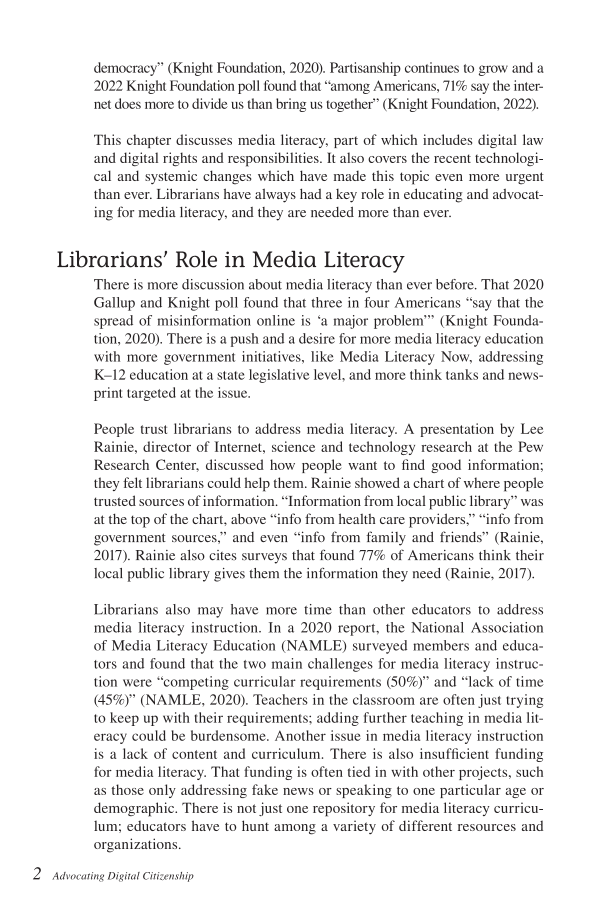2 Advocating Digital Citizenship democracy” (Knight Foundation, 2020). Partisanship continues to grow and a 2022 Knight Foundation poll found that “among Americans, 71% say the inter- net does more to divide us than bring us together” (Knight Foundation, 2022). This chapter discusses media literacy, part of which includes digital law and digital rights and responsibilities. It also covers the recent technologi- cal and systemic changes which have made this topic even more urgent than ever. Librarians have always had a key role in educating and advocat- ing for media literacy, and they are needed more than ever. Librarians’ Role in Media Literacy There is more discussion about media literacy than ever before. That 2020 Gallup and Knight poll found that three in four Americans “say that the spread of misinformation online is ‘a major problem’” (Knight Founda- tion, 2020). There is a push and a desire for more media literacy education with more government initiatives, like Media Literacy Now, addressing K–12 education at a state legislative level, and more think tanks and news- print targeted at the issue. People trust librarians to address media literacy. A presentation by Lee Rainie, director of Internet, science and technology research at the Pew Research Center, discussed how people want to find good information they felt librarians could help them. Rainie showed a chart of where people trusted sources of information. “Information from local public library” was at the top of the chart, above “info from health care providers,” “info from government sources,” and even “info from family and friends” (Rainie, 2017). Rainie also cites surveys that found 77% of Americans think their local public library gives them the information they need (Rainie, 2017). Librarians also may have more time than other educators to address media literacy instruction. In a 2020 report, the National Association of Media Literacy Education (NAMLE) surveyed members and educa- tors and found that the two main challenges for media literacy instruc- tion were “competing curricular requirements (50%)” and “lack of time (45%)” (NAMLE, 2020). Teachers in the classroom are often just trying to keep up with their requirements adding further teaching in media lit- eracy could be burdensome. Another issue in media literacy instruction is a lack of content and curriculum. There is also insufficient funding for media literacy. That funding is often tied in with other projects, such as those only addressing fake news or speaking to one particular age or demographic. There is not just one repository for media literacy curricu- lum educators have to hunt among a variety of different resources and organizations.
Document Details My Account Print multiple pages
Print
You have printed 0 times in the last 24 hours.
Your print count will reset on at .
You may print 0 more time(s) before then.
You may print a maximum of 0 pages at a time.

































































































































































































